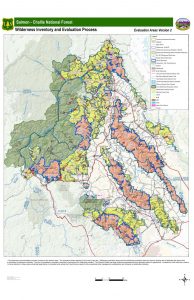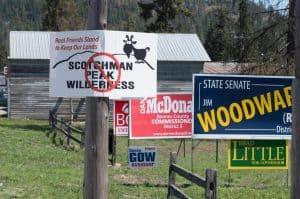I try to not get too involved in the wilderness debates (there seem to be enough people there already). But I follow planning, and this started out to be a post on the status of wilderness recommendations on the Salmon-Challis National Forest, as part of their forest plan revision process, but there was also this:
“Two places in particular really stand out,” he said. “One is the north side of the Pioneer Mountains. The southern half is in the Sawtooth National Forest and is already recommended for wilderness, and the area around Borah Peak in the Lost River Range. Those two areas we find to have exceptional wilderness character, a lot of scenic values, great wildlife habitat, opportunities for solitude and other things that fit the definition of wilderness character. These areas have been managed as wilderness areas since 1979.”
I wanted to find out what happened in 1979, because this suggests a policy of excluding mountain bikes to protect potential wilderness areas outside of Region 1 (the Salmon-Challis is in Region 4). Instead I found a recent law review article discussing the bigger issue including a couple of questions that have been key in recent posts. It includes the history of the Forest Service policy:
In 1966, the Forest Service wrote formal regulations to implement the Wilderness Act, and defined “mechanical transport” to mean a cart, sled, or other wheeled vehicle that is “powered by a non-living power source.
The Forest Service later reversed course by issuing a declaration banning bicycles in 1977…
The Forest Service flipped one last time in 1984, after various groups, including the Sierra Club and Wilderness Society, successfully convinced the agency to remove the reference to bicycles in the discretionary 1981 regulation.
There is also a good discussion of the legislative intent behind the term “mechanized transport.” The author buys into the interpretation of a previous author liked by the Sustainable Trails Coalition, “Legislative history informs the mechanical transport issue and reveals that Congress “meant to prohibit mechanical transport, even if not motorized, that (1) required the installation of infrastructure like roads, rail tracks, or docks, or (2) was large enough to have a significant physical or visual impact on the Wilderness landscape.” But she adds, “Even if the term “mechanical transport” in the Wilderness Act does not include bicycles as a matter of law, the management agencies have the discretion to ban them, as they explicitly have.” (This includes BLM and the Park Service.) She favors local discretion.
Wilderness decisions are acutely emotional and political, and what it feels like we’re witnessing is how emotions and politics shift over time, sometimes in response to technology. I personally would rather not see mountain bikes in wilderness because it makes wilderness smaller by making more remote areas more full of people, which is not a wilderness value. But maybe people like me are dying out. But I’m not convinced that bikes (large numbers over time) don’t have “a significant physical or visible impact” either, on at least most trails.
So I don’t know why the Salmon-Challis potential wilderness areas may have excluded bikes since 1979. But here is the status of planning for wilderness:
“There are groups out there like The Wilderness Society looking at us as the last best place to designate more wilderness area,” Mark said. “I’ve already got two-thirds of the forest as wilderness. I’ve got local folks, range permittees, outfitter guides and others asking ‘Well Chuck, how much more wilderness do you need?’ That’s a good question and I don’t necessarily have an answer.”
I don’t like the implication that he thinks 2/3 is necessarily a lot (especially if there are going to be more people using wilderness areas someday because they can ride their bikes there).






